Ensemble recordings in awake rats: achieving behavioral regularity during multimodal stimulus processing and discriminative learning
- PMID: 20119524
- PMCID: PMC2707140
- DOI: 10.1901/jeab.2009.92-113
Ensemble recordings in awake rats: achieving behavioral regularity during multimodal stimulus processing and discriminative learning
Abstract
To meet an increasing need to examine the neurophysiological underpinnings of behavior in rats, we developed a behavioral system for studying sensory processing, attention and discrimination learning in rats while recording firing patterns of neurons in one or more brain areas of interest. Because neuronal activity is sensitive to variations in behavior which may confound the identification of neural correlates, a specific aim of the study was to allow rats to sample sensory stimuli under conditions of strong behavioral regularity. Our behavioral system allows multimodal stimulus presentation and is coupled to modules for delivering reinforcement, simultaneous monitoring of behavior and recording of ensembles of well isolated single neurons. Using training protocols for simple and compound discrimination, we validated the behavioral system with a group of 4 rats. Within these tasks, a majority of medial prefrontal neurons showed significant firing-rate changes correlated to one or more trial events that could not be explained from significant variation in head position. Thus, ensemble recordings can be combined with discriminative learning tasks under conditions of strong behavioral regularity.
Keywords: attention; electrode; olfactory; prefrontal cortex; single unit; spike; visual discrimination.
Figures



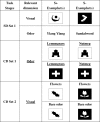
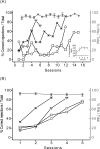
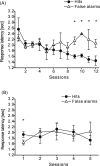
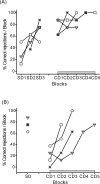
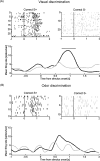

Similar articles
-
Thalamic VPM nucleus in the behaving monkey. II. Response to air-puff stimulation during discrimination and attention tasks.J Neurophysiol. 1993 Mar;69(3):753-63. doi: 10.1152/jn.1993.69.3.753. J Neurophysiol. 1993. PMID: 8385193
-
Learning-associated gamma-band phase-locking of action-outcome selective neurons in orbitofrontal cortex.J Neurosci. 2010 Jul 28;30(30):10025-38. doi: 10.1523/JNEUROSCI.0222-10.2010. J Neurosci. 2010. PMID: 20668187 Free PMC article.
-
Basolateral amygdala activity during the retrieval of associative learning under anesthesia.Neuroscience. 2013 Mar 13;233:146-56. doi: 10.1016/j.neuroscience.2012.12.039. Epub 2013 Jan 4. Neuroscience. 2013. PMID: 23295986
-
The functions of the orbitofrontal cortex.Brain Cogn. 2004 Jun;55(1):11-29. doi: 10.1016/S0278-2626(03)00277-X. Brain Cogn. 2004. PMID: 15134840 Review.
-
Convergence of sensory systems in the orbitofrontal cortex in primates and brain design for emotion.Anat Rec A Discov Mol Cell Evol Biol. 2004 Nov;281(1):1212-25. doi: 10.1002/ar.a.20126. Anat Rec A Discov Mol Cell Evol Biol. 2004. PMID: 15470678 Review.
Cited by
-
Role of nucleus accumbens shell neuronal ensembles in context-induced reinstatement of cocaine-seeking.J Neurosci. 2014 May 28;34(22):7437-46. doi: 10.1523/JNEUROSCI.0238-14.2014. J Neurosci. 2014. PMID: 24872549 Free PMC article.
-
Closing the loop for memory prosthesis: detecting the role of hippocampal neural ensembles using nonlinear models.IEEE Trans Neural Syst Rehabil Eng. 2012 Jul;20(4):510-25. doi: 10.1109/TNSRE.2012.2190942. Epub 2012 Apr 6. IEEE Trans Neural Syst Rehabil Eng. 2012. PMID: 22498704 Free PMC article.
References
-
- Baeg E.H, Kim Y.B, Huh K, Mook-Jung I, Kim H.T, Jung M.W. Dynamics of population code for working memory in the prefrontal cortex. Neuron. 2003;40:177–188. - PubMed
-
- Brigman J.L, Bussey T.J, Saksida L.M, Rothblat L.A. Discrimination of multidimensional visual stimuli by mice: intra- and extradimensional shifts. Behavioral Neuroscience. 2005;119:839–842. - PubMed
-
- Bussey T.J, Muir J.L, Robbins T.W. A novel automated touchscreen procedure for assessing learning in the rat using computer graphic stimuli. Neuroscience Research Communications. 1994;15:103–110.
Publication types
MeSH terms
LinkOut - more resources
Full Text Sources

